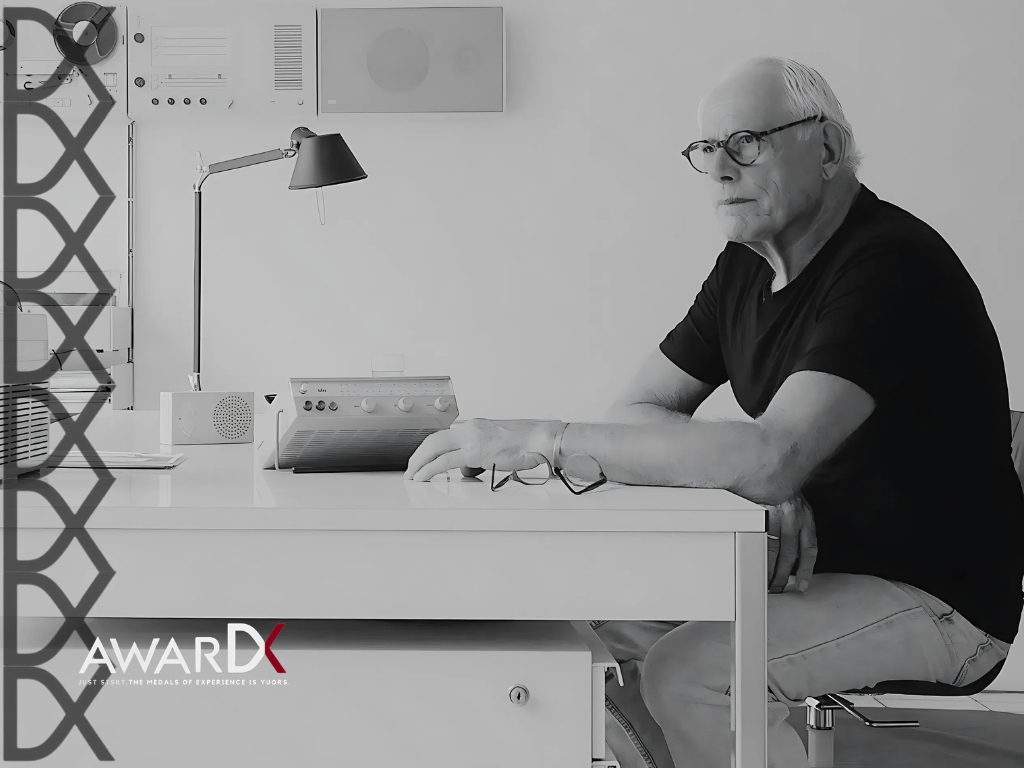Dieter Rams is one of the most influential industrial designers of the 20th century. His work for Braun and Vitsœ helped define what modern consumer products look, feel, and behave like. But beyond the objects themselves, Rams’s real legacy is a compact, durable philosophy: his Ten Principles for Good Design. Those ten rules — succinct, ethical and surprisingly business-relevant — remain a powerful lens for companies that want products customers love, teams that want clarity of purpose, and brands that want longevity and trust.
This long read unpacks Rams’s ten principles, explains why they still matter for modern product and business strategy, and gives concrete actions CEOs, product managers, and design leads can take to apply them.
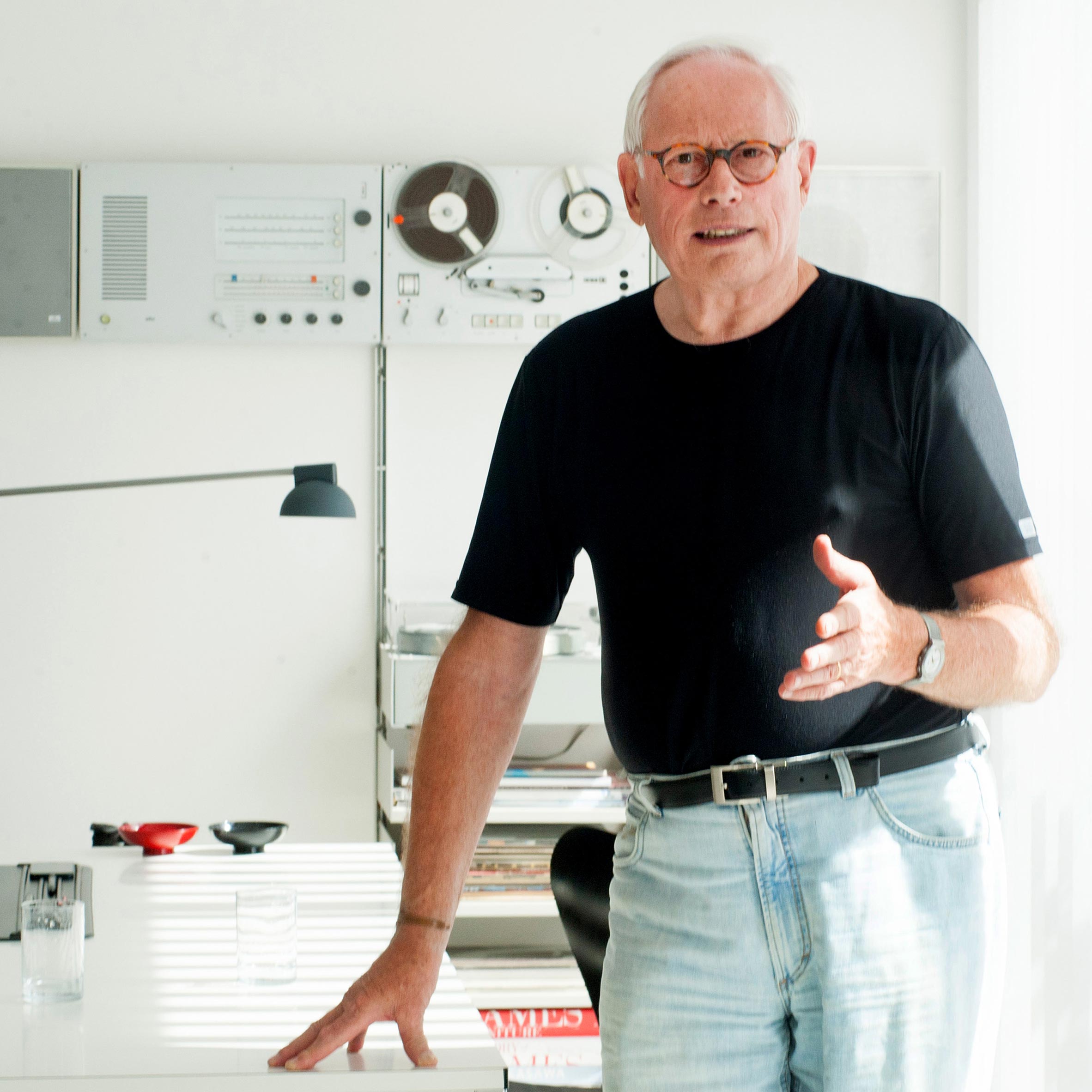
Who is Dieter Rams — short context
Dieter Rams is a German industrial designer born in 1932. He rose to prominence as head of design at Braun from the late 1950s through the 1990s and later collaborated closely with furniture maker Vitsœ. Rams’s aesthetic—minimal, honest, and functional—shaped numerous household products and influenced generations of designers. But more enduring than any single object are the principles he distilled: a moral and practical framework for making useful, responsible, and beautiful products.
Rams’s Ten Principles — overview
Rams summarized his approach in ten short, direct statements: design should be good, innovative, useful, aesthetic, understandable, unobtrusive, honest, long-lasting, thorough down to the last detail, environmentally friendly, and as little design as possible. Below each principle is unpacked with examples of interpretation and concrete recommendations you can implement.
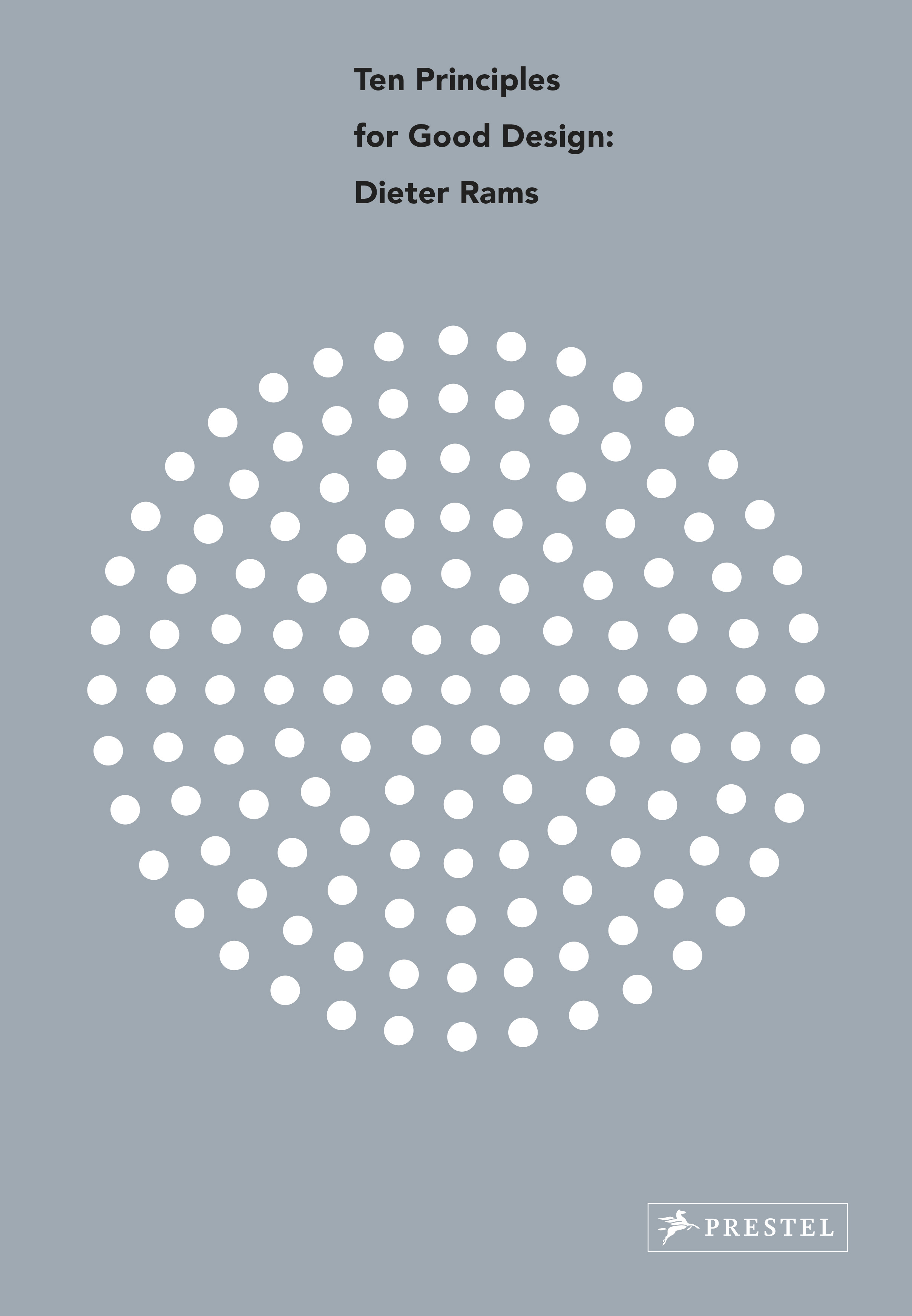
1. Good design is innovative
Rams argued that innovation must expand possibilities while remaining grounded in real needs. Innovation for its own sake—novelty without utility—fails the test.
Actionable advice:
Set an “impact before novelty” rule for R&D: every new feature must demonstrate a measurable user benefit.
Use fast experiments (prototypes + short pilot runs) to validate that innovation enhances value, not just attracts attention.
2. Good design makes a product useful
Utility is fundamental. Beauty is secondary to usefulness. A product that doesn’t do what users need cannot be redeemed by aesthetics.
Actionable advice:
Apply a “jobs-to-be-done” audit to your portfolio and remove or refocus features that don’t map to clear user jobs.
Run usability checks with non-expert users before committing to production tooling.
3. Good design is aesthetic
Form matters because a well-crafted product communicates respect for the user. Aesthetics aren’t superficial—they’re part of the product’s usability and desirability.
Actionable advice:
Treat visible parts as strategic interfaces for brand experience. Invest in a small but high-quality visual style guide for finishes, materials, and proportions.
Prioritize material and surface decisions early in the design cycle, not as an afterthought.
4. Good design makes a product understandable
A clear product reveals its purpose and operation. Users should grasp how something works without needing dense manuals.
Actionable advice:
During prototyping, measure “first-time task success” — can a user operate the product immediately? If not, iterate.
Reduce cognitive load by minimizing modes and hiding complexity behind clear affordances.
5. Good design is unobtrusive
Rams believed products should be neutral background agents in people’s lives, not screaming trophies. They should support life, not dominate it.
Actionable advice:
Evaluate your product line and remove or simplify overly showy features that don’t improve function.
For lifestyle brands, create two tiers: statement pieces and unobtrusive utility staples.
6. Good design is honest
Design should not manipulate users or exaggerate performance. Honesty builds trust and long-term customer relationships.
Actionable advice:
Ensure marketing claims match real performance. Drop features that only exist for marketing copy.
Publish transparent specs and maintenance expectations to reduce buyer remorse.
7. Good design is long-lasting
Rams criticized planned obsolescence; great design endures both technically and stylistically.
Actionable advice:
Design for upgradeability and modular repair — enable component replacement instead of whole-product replacement.
Favor timeless proportions and restrained styling over trend-driven looks; craft a “10-year design horizon” for flagship products.
8. Good design is thorough down to the last detail
Excellence is in the details: seams, tolerances, assembly methods, and interaction transitions.
Actionable advice:
Make a “last 10%” checklist that must be signed off before production (edge finish, tactile quality, labeling clarity).
Run small-scale pilot assemblies to surface detail problems early.
9. Good design is environmentally friendly
Rams’s later thinking emphasized ecology: design must reduce burden on the planet.
Actionable advice:
Calculate product-level embodied carbon or material impact and set reduction targets.
Prioritize recyclable materials, minimal packaging, and take-back or remanufacture programs.
10. Good design is as little design as possible
Simplicity is the ultimate sophistication. Remove everything that does not add direct value.
Actionable advice:
Adopt an “inverse feature audit”: for every feature, ask what would happen if it were removed. If the product still succeeds, remove it.
Use constraints in design briefs (budget, parts, surfaces) to force essentialism.
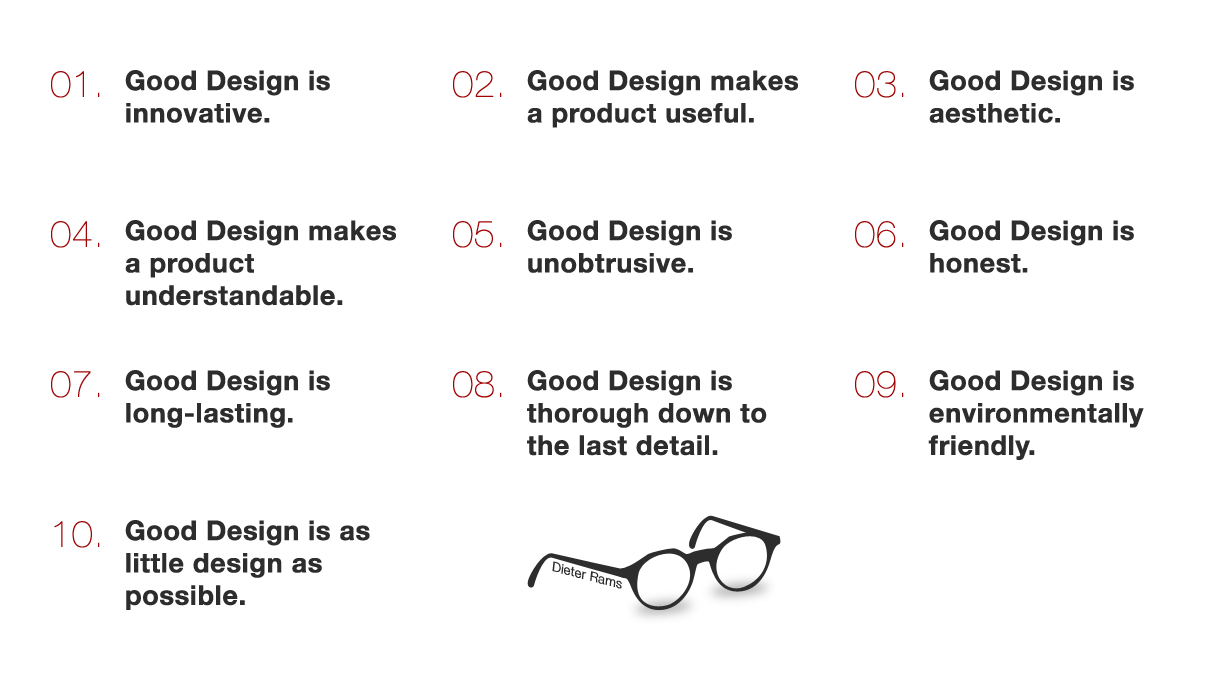
Bringing Rams’s Principles into Product Strategy
Rams’s rules are not only for designers. They provide a strategic checklist that leaders can use to align product roadmaps, R&D priorities, and brand narratives.
Executive checklist:
Integrate three principles into each product brief (e.g., “must be useful, honest, and long-lasting”).
Require a lifecycle impact assessment early in concept review.
Make an annual “durability & repairability” KPI part of product success metrics.
Ensure marketing and design sign the same product spec to avoid dishonest or overpromising messaging.
Case studies — what modern companies do well (and poorly)
Many successful companies echo Rams’s lessons: clean interfaces, clear functions, long service lives, and honest specs. Conversely, companies that prioritize feature bloat, hyper-styling, or opaque claims often burn goodwill and incur high warranty costs. The best modern examples combine rapid digital iteration with Rams-style material and interaction rigor.
Design leadership — building teams that honor the principles
To embed Rams’s thinking, hiring, structure and processes need to reinforce restraint, craft and systems thinking.
Practical moves:
Hire senior designers with portfolios demonstrating restraint and systems thinking.
Create small multidisciplinary squads (industrial designers + engineers + materials specialist) co-owned by product managers.
Reward decisions that remove features or reduce complexity as highly as those that add them.
Measuring success — metrics that reflect Rams’s thinking
Beyond revenue and NPS, measure:
Repair rate and average lifespan in the field.
Number of user tasks solved without documentation.
Product return reasons related to perceived performance vs. expectation.
Material circularity score (recyclable content, take-back program participation).
These KPIs make Rams’s abstract principles operational and business-relevant.
Rams’s Influence Today — digital products and physical goods
Although Rams worked mainly with physical goods, his principles are highly relevant to software and services: clarity of purpose, honesty in communication, durable mental models, and minimalism all translate directly to UX and product strategy. Design teams should interpret Rams not as stylistic dogma but as a mindset for reducing noise and maximizing value.
Common misunderstandings — what Rams does not mean
Rams’s minimalism is not about austerity; it’s about relevance. Less is good only when less still solves the user’s problem.
“Timeless” does not imply “boring.” It implies careful proportion, considered detail, and a refusal to chase every fad.
Environmental design is not an add-on; it’s a constraint that generates better solutions, not a marketing overlay.
Implementation roadmap — 90-day plan for leaders
Week 1–3: Internal education
Run two workshops explaining the Ten Principles. Assign each product team a principle to re-evaluate.
Week 4–8: Portfolio audit
Conduct the inverse feature audit and lifecycle scan on 3 flagship products.
Week 9–12: Pilot changes
Implement 2 small interventions (e.g., remove a non-essential feature; add modular replacement component) and measure user response and cost impact.
Outcomes: a set of validated process changes, a measurable reduction in complexity, and a leadership narrative about quality and longevity.
Why Dieter Rams still matters to CEOs
Rams’s principles align design quality with business resilience. Investing in products that are useful, honest and long-lasting reduces churn, builds trust, and lowers total cost of ownership for customers. In an era of rising consumer skepticism and regulatory pressure on sustainability, Rams provides a concise, actionable moral code that supports both brand reputation and the bottom line.
Official links for further reading:
https://www.vitsoe.com/us/about/good-design
https://www.vitsoe.com/gb/about/dieter-rams
https://www.dieter-rams-foundation.org/

